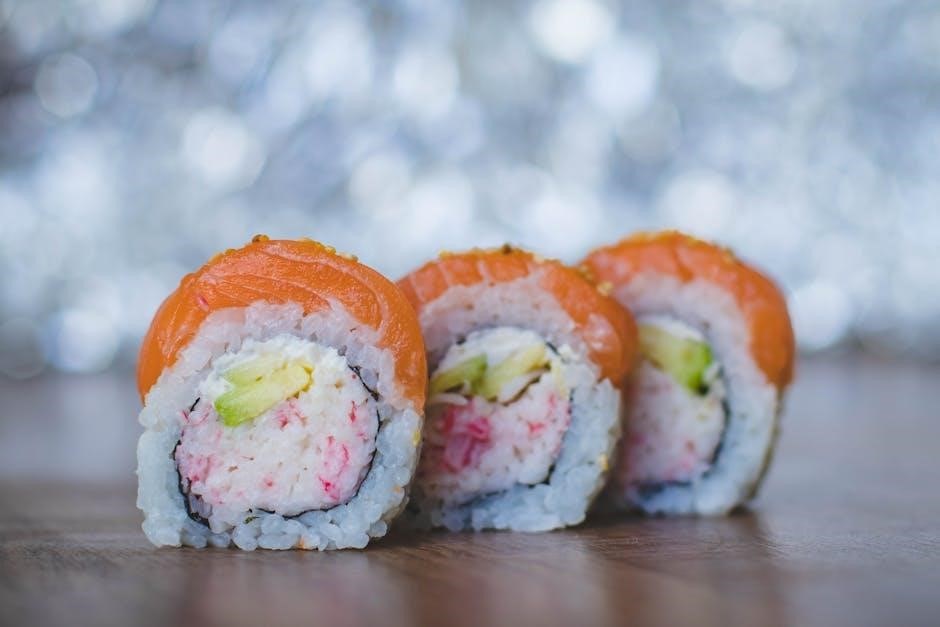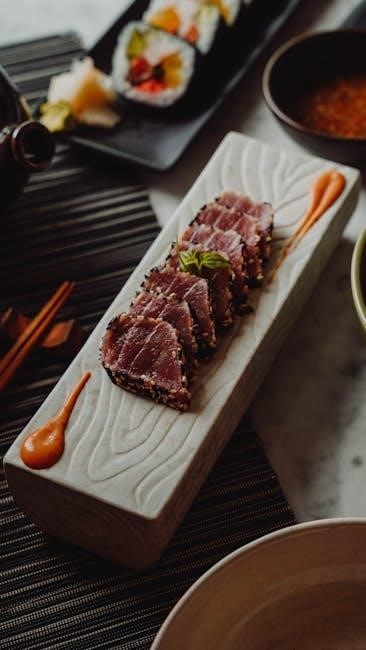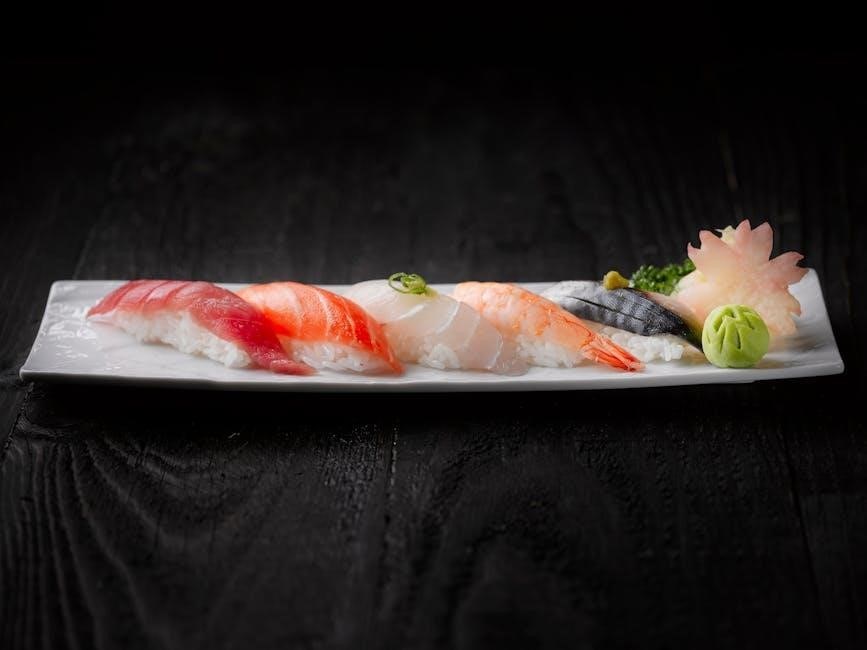Welcome to the Gong Guide Sushi‚ your ultimate handbook for mastering the art of sushi making. Discover step-by-step techniques‚ essential ingredients‚ and expert tips to craft authentic sushi at home. Whether you’re a novice or a culinary enthusiast‚ this guide will transform your sushi experience‚ ensuring delicious and professional results every time.
1.1 Understanding the Concept of Gong Guide Sushi
Gong Guide Sushi is a comprehensive resource designed to elevate your sushi-making skills and appreciation. It offers detailed insights into the world of sushi‚ covering traditional techniques‚ ingredient selection‚ and modern twists. Whether you’re a beginner or an experienced chef‚ this guide provides step-by-step instructions and expert tips to craft authentic‚ professional-quality sushi. From classic Nigiri to innovative Maki rolls‚ Gong Guide Sushi ensures a seamless culinary journey. Its focus on quality‚ freshness‚ and presentation makes it an essential tool for anyone passionate about sushi. Dive into the art of sushi with confidence‚ guided by Gong’s expertise and creativity.
1.2 Importance of Sushi in Japanese Cuisine
Sushi holds a revered place in Japanese cuisine‚ reflecting tradition‚ artistry‚ and cultural pride. It embodies the harmony of flavors‚ textures‚ and presentation‚ symbolizing Japan’s culinary excellence. Beyond its delicious taste‚ sushi represents a deep connection to seasonality and freshness‚ emphasizing local ingredients. Its preparation requires precision and skill‚ making it a celebrated dish worldwide. Sushi’s versatility allows it to cater to diverse tastes‚ from traditional raw fish to modern vegan options. It is not just a meal but an experience‚ tracing its roots to ancient fermentation techniques. Sushi’s global popularity has made it synonymous with Japanese culture‚ bridging tradition and innovation seamlessly.

Types of SushiFeatured in Gong Guide
Gong Guide showcases a variety of sushi types‚ including classic Nigiri‚ rolled Maki and Futomaki‚ cone-shaped Temaki‚ and boat-shaped Gunkan‚ each offering unique flavors and textures for every sushi lover.
2.1 Nigiri: The Classic Hand-Pressed Sushi
Nigiri is a timeless form of sushi‚ characterized by a small ball of vinegared rice topped with fresh‚ premium ingredients. Skillfully hand-pressed by chefs‚ it showcases the harmony of textures and flavors. Common toppings include sushi-grade fish like salmon‚ tuna‚ and shrimp‚ as well as egg or octopus. The simplicity of nigiri highlights the quality of its components‚ making it a favorite among sushi enthusiasts. Traditionally‚ nigiri is served without wasabi‚ allowing the natural flavors of the fish and rice to shine. This classic style is a cornerstone of sushi cuisine‚ offering an authentic and elegant dining experience.
2.2 Maki and Futomaki: The Art of Rolled Sushi
Maki and futomaki are iconic rolled sushi styles‚ crafted using bamboo mats to achieve perfect cylindrical shapes. Maki‚ the standard roll‚ typically features combinations like cucumber‚ avocado‚ or fish‚ wrapped in nori seaweed. Futomaki‚ meaning “thick roll‚” is larger and often filled with multiple ingredients‚ such as vegetables‚ egg‚ or fish‚ making it a hearty option. Both styles highlight the artistry of sushi preparation‚ with precise rolling techniques ensuring each bite is balanced. Their versatility and visual appeal make them favorites in sushi restaurants worldwide‚ offering a delightful mix of flavors and textures in every roll.
2.3 Temaki: The Cone-Shaped Sushi
Temaki‚ or hand rolls‚ are cone-shaped sushi pieces that offer a unique and flavorful experience. Typically larger than other sushi types‚ temaki is wrapped in nori seaweed and filled generously with ingredients like spicy tuna‚ crab‚ or vegetables. The cone shape allows for a variety of fillings‚ making it a popular choice for those who enjoy hearty portions. Unlike maki or nigiri‚ temaki is often eaten by hand‚ enhancing its casual and enjoyable nature. Its simplicity and versatility make it a crowd favorite‚ perfect for both beginners and sushi enthusiasts looking to explore diverse flavors in a single‚ satisfying roll.
2.4 Gunkan: The Boat-Shaped Sushi
Gunkan‚ meaning “warship” in Japanese‚ is a unique boat-shaped sushi designed to hold loose or soft ingredients. Typically formed by wrapping nori around a small ball of sushi rice‚ gunkan is then filled with delicate toppings such as uni (sea urchin)‚ ikura (salmon roe)‚ or tobiko. This style allows for the preservation of the ingredient’s natural flavor and texture‚ providing a burst of taste in each bite. Gunkan’s innovative design makes it a standout in sushi presentations‚ offering both visual appeal and culinary delight. Its creation highlights the creativity and precision of sushi craftsmanship‚ making it a favorite among sushi lovers seeking variety and quality.

Essential Ingredients for Sushi
Sushi rice‚ fresh fish‚ and nori are the fundamental ingredients. Sushi rice provides the base‚ fresh fish adds flavor‚ and nori wraps everything perfectly‚ ensuring a delightful sushi experience.
3.1 The Role of Sushi Rice
Sushi rice is the cornerstone of sushi‚ providing texture and flavor. Short-grain rice is preferred for its stickiness‚ achieved through precise rinsing and soaking. Seasoned with vinegar‚ sugar‚ and salt‚ it balances acidity and sweetness‚ enhancing sushi’s overall taste. Proper preparation ensures the rice clings together without being mushy‚ making it essential for nigiri‚ maki‚ and other forms. Freshness and quality are vital‚ as the rice’s texture and flavor significantly impact the dining experience. This foundation allows other ingredients like fish and nori to shine‚ creating a harmonious dish.
3.2 Fresh Fish and Seafood
Fresh fish and seafood are the heart of sushi‚ offering unparalleled flavor and texture. From fatty tuna to delicate salmon‚ each type of fish is carefully selected for its quality and freshness. Sushi-grade seafood must meet strict standards to ensure safety and taste. Skilled handling‚ including proper storage and slicing‚ preserves the fish’s natural flavors. Seasonality plays a role‚ with certain fish being more prized during specific times of the year. The freshness and variety of seafood elevate sushi‚ making it a culinary masterpiece. This guide highlights the best practices for selecting and preparing fish and seafood to enhance your sushi experience.
3.4 Nori: The Seaweed Sheets
Nori‚ thin sheets of seaweed‚ are a fundamental component of sushi‚ providing structure‚ flavor‚ and texture. Harvested from the ocean‚ nori is rich in umami‚ enhancing the taste of sushi. It is typically roasted or unroasted‚ with roasted nori offering a deeper flavor. Nori is used to wrap sushi rolls‚ such as maki and temaki‚ and adds crispiness to nigiri. To maintain its texture‚ nori should be stored in a dry place and handled gently to prevent tearing. Properly toasted nori sheets bring out the best in sushi‚ making it a must-have ingredient for any sushi preparation. Its versatility and flavor make nori indispensable in sushi cuisine.

Sushi Etiquette
Mastering sushi etiquette ensures a respectful and enjoyable dining experience. Proper chopstick use‚ orderly serving customs‚ and mindful table manners are essential for savoring sushi authentically and elegantly.
4.1 Chopstick Etiquette
Chopstick etiquette is a cornerstone of sushi dining‚ reflecting respect for tradition. Hold chopsticks correctly: one between the thumb and index finger‚ the other resting on the middle finger. Never point chopsticks at others or wave them in the air. Avoid passing food directly from one pair of chopsticks to another‚ as this resembles a funeral ritual. Do not leave chopsticks standing upright in rice‚ as this mimics offerings to the dead. If unsure‚ observe others or ask your server for guidance. Proper chopstick handling enhances your sushi experience and shows appreciation for Japanese customs. Practice makes perfect!
4.2 Order and Serving Customs
Understanding order and serving customs enhances your sushi experience. Typically‚ sushi is served on a wooden or lacquer plate‚ with dishes arranged artfully. It’s customary to order omakase (chef’s selection) for a tailored experience. Start with lighter dishes like cucumber rolls or delicate nigiri‚ progressing to richer options like salmon or uni. Avoid mixing wasabi directly into soy sauce‚ as it’s considered improper. Dip sushi fish-side down to preserve flavor and texture. Never pass food directly from one pair of chopsticks to another‚ as this mimics a funeral ritual. Respect the chef’s craft by enjoying each piece as served.
4.3 Dining Manners in a Sushi Restaurant
Dining manners in a sushi restaurant reflect respect for tradition and the chef’s craft. Upon entry‚ greet the chef with a bow or a polite “irasshaimase.” Use chopsticks correctly‚ avoiding crossed or standing them upright in rice. Refrain from mixing wasabi into soy sauce‚ as it’s considered disrespectful. Sushi is typically eaten with your hands or chopsticks‚ depending on the type. Never waste food; finish each piece. Avoid loud conversations and keep your phone silent. After finishing‚ thank the chef with “gochisousama deshita.” Proper etiquette enhances the dining experience‚ showing appreciation for the artistry and effort behind each dish.

Sushi Recipes for Beginners
Master sushi basics with simple recipes! Learn to prepare sushi rice‚ craft classic nigiri‚ and roll perfect maki. Essential for home cooks starting their sushi journey.
5.1 Preparing Sushi Rice
Preparing sushi rice is the foundation of making great sushi; Start by rinsing short-grain rice thoroughly to remove excess starch. Soak the rice in water for 30 minutes‚ then cook it with a 1:1 rice-to-water ratio. Once cooked‚ allow the rice to rest‚ covered‚ for 10 minutes. Mix in a seasoning of rice vinegar‚ sugar‚ and salt while the rice is warm. Gently fold the seasoning into the rice using a wooden spatula to avoid breaking the grains. Let the rice cool to room temperature before using it for sushi. Proper preparation ensures the perfect texture and flavor for your sushi creations.
5.2 Making Classic Nigiri
Making classic nigiri begins with freshly prepared sushi rice and sashimi-grade fish. Ensure your hands are wet to handle the rice without sticking. Shape a small portion of rice into an oval‚ applying gentle pressure. Slice the fish thinly‚ removing any bones or skin. Place the fish on top of the rice‚ pressing lightly to secure. For extra flavor‚ dab a touch of wasabi on the fish side before assembling. Form the nigiri by balancing the fish and rice‚ ensuring a smooth shape. Serve immediately‚ with the fish side up‚ and enjoy with soy sauce or wasabi. Proper technique ensures a delightful texture and taste.
5.3 Rolling Maki Sushi
Rolling maki sushi requires precision and practice. Start by preparing sushi rice and your chosen fillings‚ such as fish or vegetables. Lay a nori sheet flat on a bamboo sushi mat‚ spreading a thin layer of rice over it‚ leaving a small border at the top. Arrange your fillings horizontally across the middle of the rice. Roll the sushi using the mat‚ applying gentle but firm pressure to form a compact cylinder. Once rolled‚ apply even pressure to shape and tighten the roll. Slice into individual pieces using a sharp knife‚ dipping the blade in water to prevent sticking. Serve with soy sauce‚ wasabi‚ and pickled ginger for an authentic experience.

Advanced Sushi Techniques
Elevate your sushi skills with advanced methods like mastering temaki rolls and creating gunkan-style sushi. Explore intricate designs‚ precise knife work‚ and expert pairing techniques for a refined experience.
6.1 Mastering Temaki Rolls
Temaki rolls‚ known for their cone-shaped design‚ are a delightful challenge in sushi mastery. To create perfect temaki‚ start by spreading a thin layer of sushi rice onto a nori sheet‚ leaving space at the top. Add your chosen fillings‚ such as spicy tuna or crab‚ in the center. Roll the nori tightly from the bottom corner upward‚ applying gentle pressure to form a crisp cone. Ensure the nori seal is secure to hold the roll together. Practice makes perfect—mastering the balance between filling quantity and roll structure is key. Temaki rolls are not only visually appealing but also offer a satisfying texture and flavor combination‚ making them a standout in any sushi platter.
6.2 Creating Gunkan-Style Sushi
Gunkan-style sushi‚ meaning “boat-shaped‚” is a unique and visually appealing form of sushi. To create it‚ shape sushi rice into a small rectangular block. Wrap a narrow nori strip around the middle‚ forming a boat-like shape. Fill the “boat” with ingredients like uni (sea urchin)‚ ikura (salmon roe)‚ or tobiko (flying fish roe). Gunkan sushi is ideal for showcasing delicate or loose toppings. Ensure the nori is tightly sealed to hold the filling securely. This style highlights the freshness of the ingredients while adding an artistic touch to your sushi platter. Mastering Gunkan sushi is a great way to diversify your sushi-making skills and impress your guests.
6.4 Understanding Sushi Pairings
Mastering sushi pairings is an art that enhances the dining experience. Classic combinations like salmon with avocado or crab with cucumber balance flavors and textures. For a more adventurous approach‚ try pairing spicy tuna with crab or eel with uni. Soy sauce‚ wasabi‚ and pickled ginger complement sushi by enhancing its natural flavors. Pairing sushi with sake or green tea can elevate the meal‚ as their subtle notes don’t overpower the dish. Understanding these pairings allows for a harmonious balance of flavors‚ ensuring each bite is a delightful experience. Experiment with different combinations to discover your favorites and refine your sushi appreciation.

Sushi Pairing Guide
Discover expert tips for pairing sushi with drinks‚ wine‚ and desserts. From sake to green tea‚ and mango to mochi‚ elevate your sushi experience with perfect matches.
7.1 Drinks to Pair with Sushi
When enjoying sushi‚ the right drink can elevate the dining experience. Sake is a classic choice‚ offering a smooth‚ slightly sweet complement to sushi’s delicate flavors. Green tea is another popular option‚ providing a refreshing contrast to rich sushi ingredients. For a modern twist‚ sparkling water with yuzu adds a citrusy zing‚ while Japanese beer pairs well with heartier sushi options like tempura or spicy rolls. Wine enthusiasts might opt for a crisp Pinot Grigio or a light rosé to balance the meal. Experiment with these options to find your perfect match and enhance the flavors of your sushi experience.
7.2 Wine and Sake Pairings
Pairing wine and sake with sushi can elevate your dining experience. Sake‚ a traditional Japanese rice wine‚ complements sushi’s delicate flavors‚ especially when paired with raw fish like salmon or tuna. For wine‚ a crisp Pinot Grigio pairs beautifully with lighter sushi options‚ while a light rosé enhances the richness of fatty tuna or uni. Gewürztraminer works well with spicy rolls due to its aromatic and slightly sweet notes. When choosing sake‚ opt for a daiginjo for its refined‚ clean taste‚ or a junmai for a richer‚ earthier profile. Experiment with these pairings to find the perfect harmony for your sushi journey.
7.3 Desserts to Follow Sushi
After indulging in sushi‚ a sweet treat can perfectly round off your meal. Japanese desserts like mochi ice cream or manju offer a delicate transition from savory to sweet. Daifuku‚ a glutinous rice cake filled with red bean paste‚ is another traditional option. For a modern twist‚ tempura ice cream combines crispy tempura bits with creamy vanilla. Western-inspired desserts like green tea tiramisu or mango cheesecake are also popular‚ blending Japanese flavors with global appeal. These desserts provide a refreshing finale to your sushi dining experience‚ ensuring a balanced and satisfying meal from start to finish.

Gong’s Sushi Surprise in Puzzle Quest 3
Embark on Gong’s Sushi Surprise in Puzzle Quest 3 for a unique culinary adventure. Discover hidden sushi recipes‚ characters‚ and tips to enhance your gameplay experience.
8.1 Overview of the Adventure
Gong’s Sushi Surprise in Puzzle Quest 3 offers an engaging culinary adventure‚ blending puzzle-solving with sushi crafting. Players explore vibrant levels‚ uncovering hidden sushi recipes and characters. The adventure introduces unique sushi-themed challenges‚ where matching puzzle pieces unlocks ingredients and cooking techniques. As you progress‚ you’ll discover how to create authentic sushi dishes‚ enhancing your gameplay and culinary knowledge. This innovative fusion of puzzles and sushi-making provides a fun and educational experience‚ perfect for both food enthusiasts and gamers. Dive into Gong’s Sushi Surprise to unravel the secrets of sushi while enjoying the exciting world of Puzzle Quest 3.
8.2 Useful Tips for the Adventure
Mastering Gong’s Sushi Surprise in Puzzle Quest 3 requires skill and strategy. Focus on matching puzzle pieces to unlock rare ingredients and special sushi recipes. Use power-ups wisely to clear levels faster and earn bonuses. Collect and upgrade your sushi cards to enhance your abilities and progress through the story. Pay attention to character skills‚ as they can provide unique advantages in specific levels. Experiment with different sushi combinations to discover hidden powers and boosts. Regularly check your inventory to ensure you have enough resources for crafting. By following these tips‚ you’ll navigate the adventure effortlessly‚ unlocking new sushi creations and achieving victory in every challenge.

Health Benefits of Sushi
Sushi offers numerous health benefits‚ including high protein‚ low calories‚ and essential vitamins from fresh fish and seaweed. It promotes a balanced diet rich in omega-3 fatty acids and minerals‚ supporting heart health and digestion. A great source of antioxidants‚ sushi can boost immunity and overall well-being when prepared with quality ingredients. Opting for healthier options like brown rice and minimal sauces enhances its nutritional value. Incorporating sushi into your diet can contribute to a healthier‚ more energetic lifestyle‚ making it a delicious and nutritious choice for many.
9.1 Nutritional Value of Sushi
Sushi is a nutrient-rich food‚ offering a balance of protein‚ vitamins‚ and minerals; Fresh fish provides essential omega-3 fatty acids‚ which support heart health and brain function. Sushi rice is a good source of carbohydrates‚ while seaweed adds fiber‚ vitamins‚ and minerals like iodine and iron. Many sushi rolls include vegetables‚ boosting vitamin and antioxidant intake. Lean proteins from fish and seafood help maintain muscle health. Sushi is also low in calories when prepared without heavy sauces or fried ingredients‚ making it a healthy choice for weight management. Overall‚ sushi is a wholesome option‚ combining flavors with nutritional benefits for a balanced diet.
9.2 Healthier Sushi Options
For a healthier sushi experience‚ opt for options rich in nutrients and lower in calories. Choose nigiri with fresh‚ lean fish like salmon or tuna‚ which are high in omega-3 fatty acids. Cucumber or avocado rolls are excellent vegetarian choices‚ offering fiber and healthy fats. Brown rice sushi provides more fiber compared to white rice. Avoid rolls with heavy sauces or fried ingredients. Instead‚ ask for light soy sauce or ponzu for dipping. Seaweed-based sushi‚ like hoso maki‚ adds vitamins and minerals. Vegan sushi options‚ such as veggie temaki‚ are also a great choice for plant-based diets. Pair your meal with green tea for added antioxidants.
Sushi Trends in 2025
In 2025‚ sushi trends emphasize vegan sushi and fusion creations‚ blending traditional flavors with modern twists. These innovative options cater to diverse tastes‚ making sushi more accessible and exciting than ever.
10.1 Rise of Vegan Sushi
The rise of vegan sushi is one of the most notable trends in 2025‚ offering plant-based alternatives that cater to diverse dietary preferences. With increasing demand for cruelty-free and sustainable options‚ chefs are innovating by substituting traditional fish with ingredients like avocado‚ tofu‚ and pickled vegetables. Vegan sushi is not only appealing to vegans but also to health-conscious diners and those seeking new flavors. Restaurants like Gong are leading this movement‚ offering affordably priced vegan sushi options that are both creative and delicious. This trend reflects a broader shift toward ethical eating‚ making sushi more accessible and inclusive for everyone.
10.2 Fusion Sushi Creations
Fusion sushi is redefining the culinary landscape by blending traditional techniques with modern flavors. Restaurants like Gong are pioneering this trend‚ offering unique creations such as sushi doughnuts‚ ravioli dumplings‚ and stuffed buns. These innovative dishes combine unexpected ingredients‚ like avocado‚ mock meats‚ and creative sauces‚ to create bold and exciting flavors. Fusion sushi appeals to adventurous eaters and those seeking something beyond classic rolls; It’s a testament to the versatility of sushi‚ allowing chefs to experiment and cater to diverse palates. This trend not only attracts food enthusiasts but also highlights the evolving nature of sushi in contemporary cuisine.

Upgrading Gong in Sushi Restaurant
Upgrading Gong enhances your sushi restaurant experience‚ offering increased customer tips‚ diverse menu varieties‚ and unique sushi creations. Elevate your culinary journey with quality ingredients and expert techniques.
11.1 Increasing Customer Tips
Enhancing customer satisfaction is key to boosting tips in Gong’s sushi restaurant. Focus on exceptional service‚ ensuring staff are attentive and knowledgeable. Present sushi attractively‚ as visually appealing dishes often receive higher gratuities. Offer unique menu items and seasonal specials to intrigue diners‚ encouraging larger orders. Highlighting premium ingredients and expert preparation can justify higher tips. Encourage staff to engage with customers‚ make personalized recommendations‚ and create a welcoming atmosphere. Positive reviews and word-of-mouth can also drive repeat visits‚ further increasing tipping potential. Prioritize quality and consistency to build a loyal customer base and maximize tips effectively.
11.2 Exploring Menu Varieties
Gong Guide Sushi offers an extensive menu featuring a wide range of options to cater to diverse tastes. From classic nigiri and maki rolls to innovative temaki and gunkan styles‚ the variety ensures there’s something for everyone. The menu highlights fresh‚ high-quality ingredients‚ blending traditional techniques with modern creativity. Exploring these options allows diners to experience the richness of sushi culture while discovering new flavors. Whether you prefer vegetarian choices or premium seafood‚ Gong’s menu is designed to delight both novices and sushi enthusiasts‚ ensuring a memorable dining experience with every dish.

